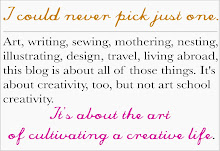I'm a latecomer to the
Glee obsession. My August
NaNoWriMo writing binge was followed by three days of the first season of Glee with breaks to sleep, eat, shower, and feed my kids. It has become a post-project ritual to dive into entire seasons of shows and catch up on movies I've missed.
Glee is research, I reason. I just finished the first draft of a young adult novel and don't want to appear clueless about American pop culture.
At the same time, I've been following along with the
Franzen-Picoult-Weiner debate, a discussion on the extensive coverage of Jonathan Franzen's newly released book,
Freedom,

sparked by
Jodi Picoult
and
Jennifer Weiner
. Bestselling writers Picoult and Weiner argue Franzen's star treatment makes commercial writers, especially commercial women writers, look excluded from the literary boy's club.
Glee and the FPW debate both point to the supposed pop culture vs. high art divide
. Seven examples show Glee and FPW might not make such strange bedfellows.
1.
Opposites attract. Glee club and football practice. Reading
Alain de Botton
followed by
Candace Bushnell
. We need
variety or get bored as a species. Where would we be without the complementary colors on a color wheel? We're
uncomfortable with consumption, but don't want to have to choose just one type of cultural food. While I love the rich flavor of a
yogurt lassi made from scratch, drinking diet Cherry Coke reminds me of going to the dollar theatre with my best friend for double features. One summer I read as many of the
Stephanie Plum books I could find while traveling through Europe. I ate at a Burger King in Groningen, the Netherlands with a Dutch friend who'd spent time in the States and was not repelled by Americana.
Can you be comfortable with fusion and relish variation and opposites?
2.
Readers and viewers like a good show. Bestsellers make readers excited. What happens next? A bestselling author knows how to keep their readers guessing and coming back for more. Likewise, the buildup to Franzen's book release was borderline fanatic and giddy. It's not about good or bad, it's about getting a show. Glee, without a doubt, made me flashback to high school. My most quietest introverted friend forever captured the heart of my 1997 senior class by dancing along to
I Will Survive in a sparkling blue floor-length gown to thunderous applause. Want to keep people interested? Surprise them.
3.
They bring out the love and the hate. Met many people indifferent to Glee, Jonathan Franzen, Jodi Picoult, Jennifer Weiner? Unlikely.
4.
Competition makes people sport their full regalia. Glee is obvious with its costumes, but couldn't it also be said that writers rise to the occasion when they defend their genre? We get to see who throws a literary punch better than someone else, who can write themselves out of their corner, who just thinks its a colossal waste of their time to care and retreats to their bench. It's the thrill of the fight, not choosing the winner, that keeps us enthralled.
5.
After it gets duked it out, everyone gets back to work. Write, dance, paint, sew, whatever the creative preoccupation, everyone gets back to it. Or risks losing their jobs or passion in life. Smart creative people never show every trick at one time to conserve energy for the work.
6.
The line between pop culture and high art is blurry.
Andy Warhol is the classic example of an artist who inserted himself into pop culture while satirically criticizing the mainstream. Despite its cast of misfits, the Glee soundtrack has sold 7 million copies.
7. They point to what people care about. And sometimes what people care about makes no sense. Sometimes it seems pointless. Awful. Sometimes it seems noble. Sometimes it is
the voice that breaks the silence. As an observer, it is fascinating. And there's not more fertile stuff for novel writing than the tension between two opposing sides.
There's something really attractive about liking something you're not supposed to.





















